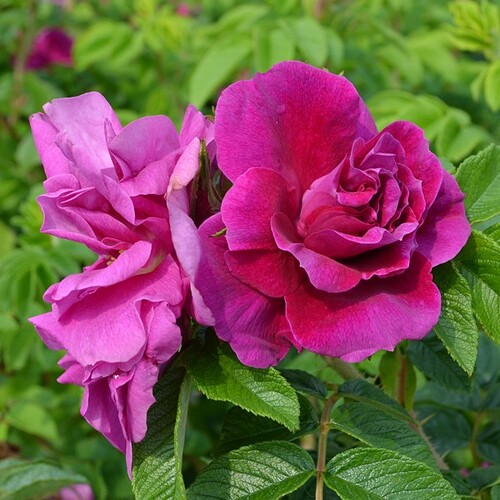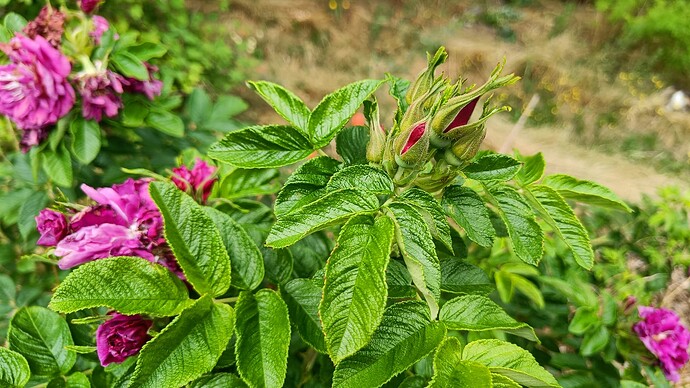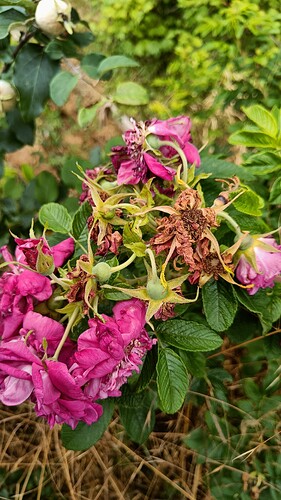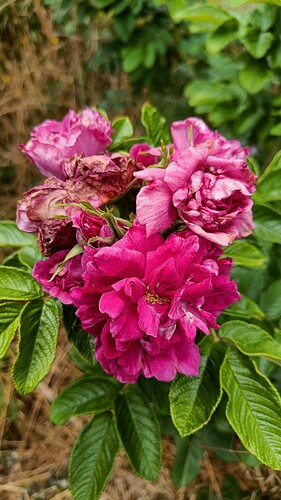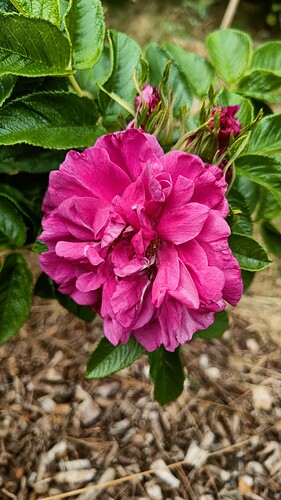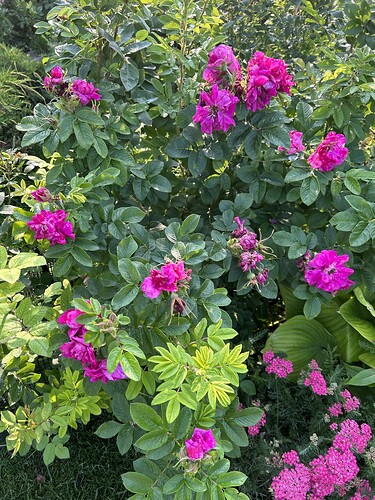Txs Paul, definitely interested and the effort, whether it comes to fruition, or not, is appreciated in advance.
Paul,
I’m a little disappointed–I had hoped that you would not make the debate personal. I’m not “fixated,” I’m trying to lay out evidence to support my hypothesis, and debunking what I believe to be false claims with evidence and logic. I am supporting my points of view with specific characteristics whenever I can, as opposed to merely throwing out my own contrary views and asserting that I am right without providing any details whatsoever. I’ll let others judge which one of us is approaching the argument in the correct way, but I had hoped that you might be willing to resolve this with facts.
There is no real debate that ‘Maiden’s Blush’ and ‘Banshee’ are completely different roses of unrelated background. The “Loyalist Rose” as it has been traditionally known in Canada seems, in fact, to be considered by most rosarians to be a form of ‘Banshee’ as it is known in the United States and certainly by some in Canada. It is absolutely not ‘Maiden’s Blush’, but the at least partially apocryphal history of the rose as documented by the Loyalists conflates the two by stating that their emblematic rose is, in fact, the Alba. It matters, then, whether they planted their garden in Vancouver with the “Loyalist Rose” that is really a form of ‘Banshee’, or with the Alba ‘Maiden’s Blush’.
If you can’t see how figuring out more about the correct identity, history, genetics, and cytology of the ‘Banshee’ complex matters, then I am sorry. I clearly have been wrong to engage you. I also apologize to Joe, since this wasn’t even meant to be a focus of the current conversation.
Stefan
Stefan, no need for you to apologize. Sending threads off on tangents is part of the fun around here. Thank you for your mature and thoughtful contributions.
Thanks, Joe! That makes me feel a bit better. (I finally just had luck resetting my password after many failed previous attempts, so sorry to everyone for the odd messages coming from my alternate ID for months.)
Stefan
My hardiest rebloomers is a (Rosa woodsii ‘Native for me in Northern Alberta’) X Fru Dagmar Hastrop) X (mixed sibling pollen) after this extremely cold winter. These semi hardiest that others use really don’t hack it.
Joe more out of curiosity, pitfall avoidance, and because l think you used it, how have your crosses done using Red Dawn x Suzanne ?
Mine is 5 years but is so cane hardy l got to get serious with it. What l find as off spring are not cane hardy in my garden.
Can’t find a ploidy ?
Riku, I used RDXS a bit quite a few years ago but gave up because it didn’t seem to pass on rebloom very often if at all, and the plant itself got some fairly ugly spotting. I had one odd reblooming seedling that came from (R. carolina x RDxS) x Commander Gillette, which is not a cross that should have produced rebloomers.
I would assume that RDxS would be a tetraploid.
I’d hate to see you avoid using it based solely on my testimony, however.
Thanks for the experience info and ploidy. I have only seen late season PM (believe Calgary low pressure) and leaf miner, this year, or something else - though surprised if latter rose dependent.
Hi Joe, Your rose does not look like ‘Hansa’. It looks like ‘David Thompson’, the Explorer Rose (which as I remember doesn’t set many hips.) Hansa has more petals and has the potential for a deeper color. Here is a pirated picture of ‘Hansa’ that I found from the internet.
Joes been absent for a couple years from forum.
The photo may have been confused. A visitor to his nursery has the same rose (imo) photo labelled as Hansen’s Yatkan in HMF (aka user labelled “heliotrop)”.
Only Joe knows for sure … Yatkan coming this spring so comparison only few months away.
… and l agree does not have the same color as mine received as Hansa … almost un-mistakable … but then l be calling the kettle black, me being the pot
Riku, “heliotrope” is me. The Yatkan pic is different than the Hansa. Maybe I should plant a new Hansa and try again. My plant labeled Hansa was likely sourced from Bailey Nursery.
My latest avenue for finding a hardy reblooming diploid is Metis, which has shown itself to produce a percentage of reblooming seedlings when crossed with rebloomers. In fact, one or two rebloomers have come out of a population of open-pollinated Metis seeds. One of them is not a rugosa type, and it’s pollen seems diploid.
I’m sorry I lost a cool thornless OP of Henry Hudson that my dad mistakenly grubbed out, because the potential for rebloom may have lurked there, and I would like to develop a hardy, thornless climbing rose for cold climates.
You’ve been missed, Joe! Welcome “home”!
Yo, Kim! Gotta get used to this new format.
You will, it’s easy!
I wasn’t crazy. Forum and Kim both confirmed that Joe has been AWOL! LOL. Welcome back, Joe!
[Edit: And I had not looked far enough back on this thread to see that Bill Radler was posting! ![]() Great to hear your voice again!]
Great to hear your voice again!]
For what it’s worth. This is my Hansa starting second bloom. Sets many hips. Unfortunately I’ve recently removed most of the spent blooms and first hips setting.
There’s a very similar rose that hardly sets hips, Rosaraie de l’Hay.
I liked Karel’s “real life photo” so much that added my own.
The below is the second as received Hansa this morning.
Baked by all day sun in front. Blooms very well and lots hips. First glam photo plant shaded most of day in back north garden. The front one is pruned and de-hipped due to “for show” front garden maintenance driving objective.
The third one in back has not performed so well for awhile.
l have never seen bad anemia on Hansa in 15 to 20 years.
Notice the anemia on its neighbour “Snow Pavement”.
Unfortunately my Rosaire de l Hay and Parfume de l Hay examples disappeared naturally and permanently … l assume winter … or wrong rootstock. They were supplied by Pickering a long tome ago - they like to use MF rootstock.
All the Hansa have had fits, and gone nearly to the ground in some springs, but l claim its is self regeneration time. Takes a couple years to gain respectability.
Tried “ Schneezwerg” that came with good references, but planted in wrong spot and a too shaded one. Never noticed a problem but being near giants it slowly disappeared and not been inclined to replace …
Hi Riku.
Your Hansa looks like the Pohjolan Kunigatar rose. Note narrow leaves.
Although the R. rugosa was brought to Europe as early as the end of the 18th century, breeding began only in the 1860s in St. Petersburg, Russia. 1870 Eduard Regel, Director of the Botanical Garden of the St. Petersburg Academy of Sciences, introduced the purple rose “Tsaritsa Severa”, “Kaiserin des Nordens” (R. davurica x unknown rugosa hybrid). The St.Petersburg Regel & Kesselring nursery also brought seedlings to Finland, where the rose also got the Finnish name ’Pohjolan kuningatar’ (“Queen of the North”). This rose has been preserved in old gardens up to northern Finland. ‘Kaiserin des Nordens’ is a graceful shrub whose small, light leaves are pointed. Flowers are smaller and darker than those of Hansa, doesn’t rebloom as well as Hansa. Produce only few hips.
